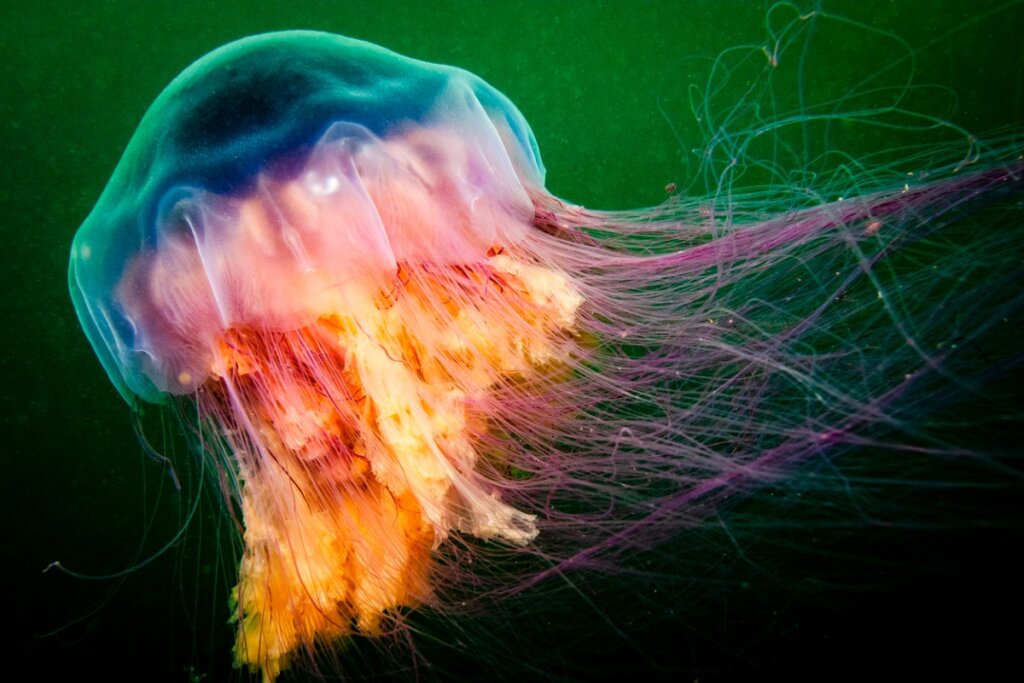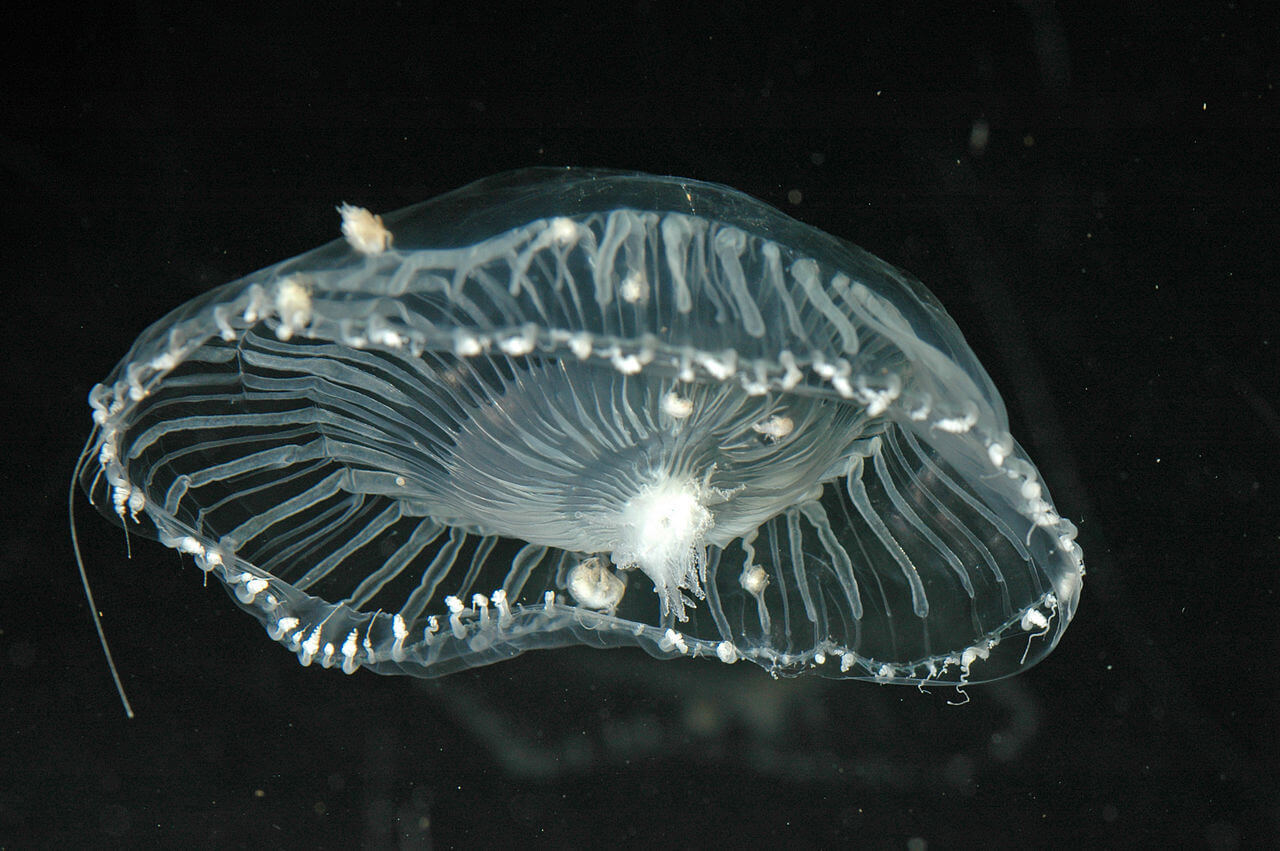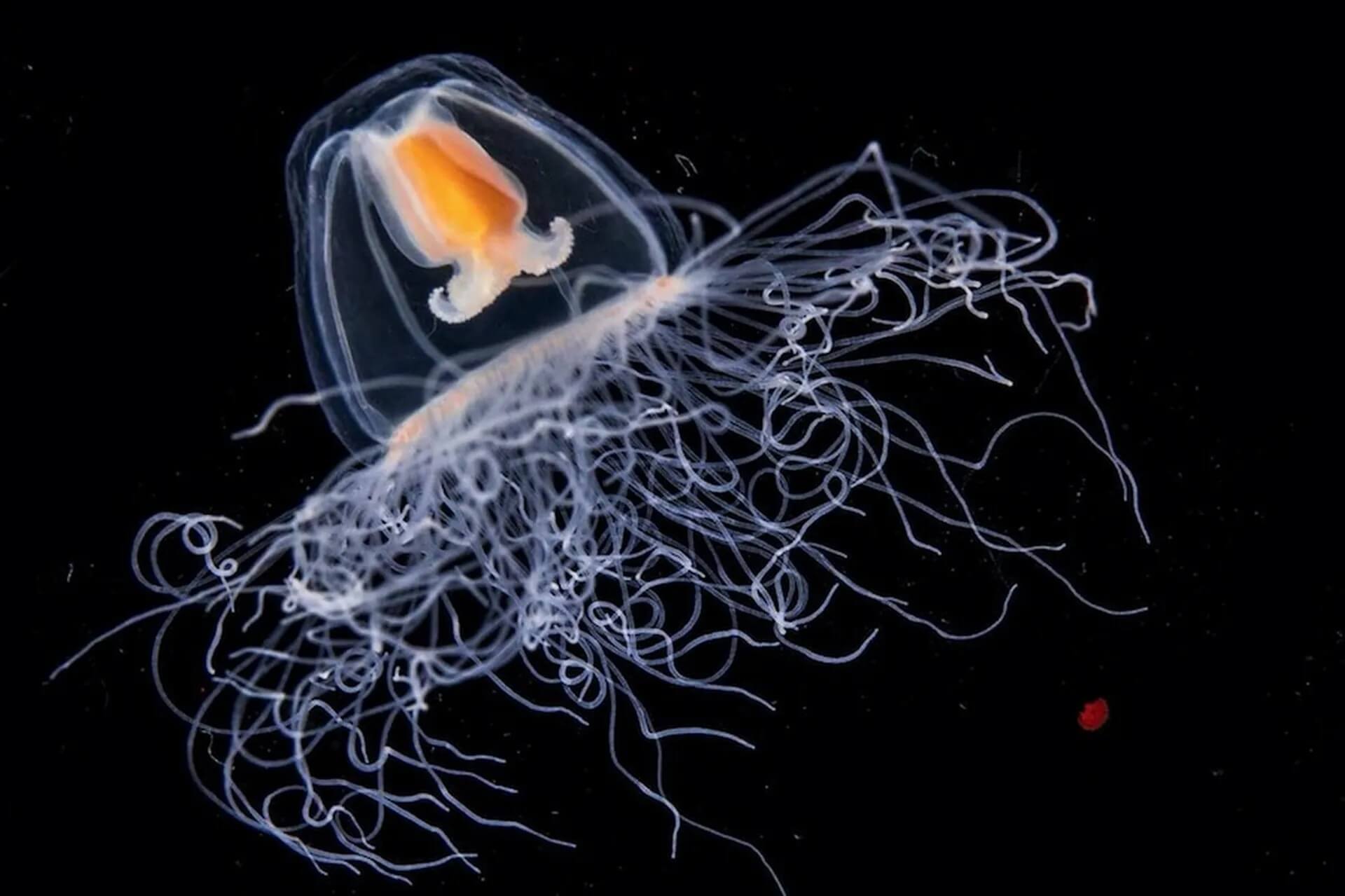The Importance of Jellyfish: Why Are They So Necessary?


Written and verified by the biologist Georgelin Espinoza Medina
Jellyfish are one of the two morphological types of animals belonging to the group of cnidarians. This taxon is comprised of about 15,088 species. Most of them inhabit marine waters, but a few specimens are found in freshwater environments. Some are dangerous to humans. Do you know the importance of jellyfish? Why are they so necessary?
Although there are some specimens that are deadly to humans, you’ll be surprised to know that some of them can be used for culinary purposes. Likewise, some compounds in their bodies play an important role in medicine. If you want to discover these and other details, be sure to read this article. We’ll bring you everything you want to know regarding the value of jellyfish in the world.
Jellyfish characteristics
Before describing the curiosities and importance of jellyfish and why they’re so necessary, let’s take a look at their physical characteristics:
- A bell-shaped body: This is known as the umbrella. In addition, its consistency is gelatinous, with an aboral zone called the exumbella and an oral zone, known as the subumbella.
- Long tentacles: They’re of variable length, according to the species, and they’re found on the periphery of the umbel. In fact, they surround the opening that serves as the mouth and anus and project outward from the body.
- Movement by flotation, at the mercy of currents: Although some species can swim freely.
- Endowment of special cells, called “cnidocysts“: These contain stinging substances and can produce venom. They’re related to different functions, which include food capture, defense, and adhesion.
Cnidocysts are specialized cells unique to the cnidarian group. From them comes the name of the taxon.

The ecological importance of jellyfish
Cnidarians – including jellyfish – are an essential part of the aquatic ecosystems they occupy. This is due to their participation in food webs as predators. Their diet includes the following components:
- Crustaceans
- Mollusks
- Small fish
- Eggs and larvae
They can also provide shelter for certain marine animals. At the same time, the organization Oceana specifies that they also serve as food for other beings. Among them, we can mention the following:
- Turtles
- Birds
- Some fish
- Crabs
- Whale sharks
- Mollusks
- Whales
- Other cnidarians
Jellyfish as a food resource for humans
Although it may seem incredible, jellyfish are also eaten by humans. This practice is common in Asian countries, such as China and Japan. It’s also an ancient custom dating back to 200 and 300 B.C.
These resources are taken advantage of thanks to their protein and healthy fatty acid composition (omega-3 and 6). In addition, they’re low in fat and cholesterol.
Generally, the largest species are used, including about 10 specimens of the order Rhizostomae. They’re marketed semi-dried and are a real delicacy. Likewise, this generates an economic importance. For example, Mexico exports the cannonball jellyfish (Stomolophus meleagris) to other countries for consumption.
The importance of jellyfish in medicine

One of the most remarkable aspects of some of these animals is their bioluminescence. A characteristic that has brought them great relevance in the medical field. This is thanks to the discovery of a green fluorescent protein in the species Aequorea victoria, which has applications in various areas. Among them are those mentioned below:
- Cellular and molecular biology
- Microbiology
- Physiology
- Genetic engineering
This discovery allowed humans to unravel previously unknown and invisible aspects. Among them are the way cancer cells spread and the development of Alzheimer’s disease. These advances have expanded what was previously known about these diseases.
Furthermore, research on jellyfish and cnidarians has led to a better understanding of other important processes, including anaphylaxis. The toxins of some specimens are also being studied as a source of bioactive products with different properties:
- Antibacterial
- Enzymatic
- Cytolytic
- Immunostimulants
They’re also a source of the compound called hyaluronic acid, which is used in plastic surgery and ophthalmology. They’re also a source of collagen, which has uses in medicine and the cosmetic industry.
The evolutionary importance of jellyfish

Although they seem to be of little relevance, they’re good candidates for studying the evolution of metazoans because they represent the most ancestral state of the group.
In addition to their characteristics, in these cnidarians, there’s the leap of the formation of a third layer of tissue during development, from the polyp state to certain jellyfish, such as some that belong to the taxon of hydromedusae.
Another relevant aspect is that jellyfish also have skeletons similar to those of other groups of more advanced animals, such as arthropods and vertebrates.
They also have a unique capacity for cellular organization, which isn’t present in other organisms. This is the case of the “immortal jellyfish” (Turritopsis nutricula), which goes from tissue dedifferentiation to an impressive complete body reorganization.
The immortal jellyfish is known by this name because it has the ability to change from jellyfish to polyp, i.e., according to the circumstances, it can return to its initial stages of development.
Their cells dedifferentiate, organize, and redifferentiate again to form polyps, from which they can also sprout jellyfish.
The Albert I Prince of Monaco Foundation Oceanographic Institute explains that thanks to this capacity for tissue dedifferentiation and body reorganization, they’re key organisms for understanding evolution and cellular transformation.
Other uses of jellyfish
In addition to the aspects mentioned so far, jellyfish are also important for other reasons. Other uses are listed below:
- Diapers and feminine products: A biodegradable absorbent material, called “jellysorb”, is present in their body, with applications in feminine products and diapers.
- Aquarophilia: Some species are quite showy, so they’re used for breeding in aquariums. The most commonly used are those larger than 4 inches. Some specimens are the moon jellyfish (Aurelia aurita), the Atlantic sea nettle (Chrysaora quinquecirrha), and the white spotted jellyfish (Phyllorhiza punctata).
The disadvantages of jellyfish
On the other hand, although their existence is necessary to maintain the ecological balance, they also generate a negative impact. Particularly when they’re found in greater numbers. This is because they contribute to the reduction of some wild fish populations, including commercially important specimens, which translates into a negative effect on fishing.
They also generate a problem for public health, due to the discomfort caused by their stings. Some species are dangerous and even fatal. The sea wasp (Chironex fleckeri) is the most poisonous specimen because it can kill a person in a short period of time (just a few minutes).
Jellyfish are fascinating beings for science
Throughout this text, we’ve explained the importance of jellyfish in different areas, from the ecological point of view -given their role in food chains-, culinary, evolutionary, and even in science and medicine. They’re beings with a simple morphology, but day by day, they fascinate scientists more and more because of all the secrets they hide in their bodies.
Jellyfish are one of the two morphological types of animals belonging to the group of cnidarians. This taxon is comprised of about 15,088 species. Most of them inhabit marine waters, but a few specimens are found in freshwater environments. Some are dangerous to humans. Do you know the importance of jellyfish? Why are they so necessary?
Although there are some specimens that are deadly to humans, you’ll be surprised to know that some of them can be used for culinary purposes. Likewise, some compounds in their bodies play an important role in medicine. If you want to discover these and other details, be sure to read this article. We’ll bring you everything you want to know regarding the value of jellyfish in the world.
Jellyfish characteristics
Before describing the curiosities and importance of jellyfish and why they’re so necessary, let’s take a look at their physical characteristics:
- A bell-shaped body: This is known as the umbrella. In addition, its consistency is gelatinous, with an aboral zone called the exumbella and an oral zone, known as the subumbella.
- Long tentacles: They’re of variable length, according to the species, and they’re found on the periphery of the umbel. In fact, they surround the opening that serves as the mouth and anus and project outward from the body.
- Movement by flotation, at the mercy of currents: Although some species can swim freely.
- Endowment of special cells, called “cnidocysts“: These contain stinging substances and can produce venom. They’re related to different functions, which include food capture, defense, and adhesion.
Cnidocysts are specialized cells unique to the cnidarian group. From them comes the name of the taxon.

The ecological importance of jellyfish
Cnidarians – including jellyfish – are an essential part of the aquatic ecosystems they occupy. This is due to their participation in food webs as predators. Their diet includes the following components:
- Crustaceans
- Mollusks
- Small fish
- Eggs and larvae
They can also provide shelter for certain marine animals. At the same time, the organization Oceana specifies that they also serve as food for other beings. Among them, we can mention the following:
- Turtles
- Birds
- Some fish
- Crabs
- Whale sharks
- Mollusks
- Whales
- Other cnidarians
Jellyfish as a food resource for humans
Although it may seem incredible, jellyfish are also eaten by humans. This practice is common in Asian countries, such as China and Japan. It’s also an ancient custom dating back to 200 and 300 B.C.
These resources are taken advantage of thanks to their protein and healthy fatty acid composition (omega-3 and 6). In addition, they’re low in fat and cholesterol.
Generally, the largest species are used, including about 10 specimens of the order Rhizostomae. They’re marketed semi-dried and are a real delicacy. Likewise, this generates an economic importance. For example, Mexico exports the cannonball jellyfish (Stomolophus meleagris) to other countries for consumption.
The importance of jellyfish in medicine

One of the most remarkable aspects of some of these animals is their bioluminescence. A characteristic that has brought them great relevance in the medical field. This is thanks to the discovery of a green fluorescent protein in the species Aequorea victoria, which has applications in various areas. Among them are those mentioned below:
- Cellular and molecular biology
- Microbiology
- Physiology
- Genetic engineering
This discovery allowed humans to unravel previously unknown and invisible aspects. Among them are the way cancer cells spread and the development of Alzheimer’s disease. These advances have expanded what was previously known about these diseases.
Furthermore, research on jellyfish and cnidarians has led to a better understanding of other important processes, including anaphylaxis. The toxins of some specimens are also being studied as a source of bioactive products with different properties:
- Antibacterial
- Enzymatic
- Cytolytic
- Immunostimulants
They’re also a source of the compound called hyaluronic acid, which is used in plastic surgery and ophthalmology. They’re also a source of collagen, which has uses in medicine and the cosmetic industry.
The evolutionary importance of jellyfish

Although they seem to be of little relevance, they’re good candidates for studying the evolution of metazoans because they represent the most ancestral state of the group.
In addition to their characteristics, in these cnidarians, there’s the leap of the formation of a third layer of tissue during development, from the polyp state to certain jellyfish, such as some that belong to the taxon of hydromedusae.
Another relevant aspect is that jellyfish also have skeletons similar to those of other groups of more advanced animals, such as arthropods and vertebrates.
They also have a unique capacity for cellular organization, which isn’t present in other organisms. This is the case of the “immortal jellyfish” (Turritopsis nutricula), which goes from tissue dedifferentiation to an impressive complete body reorganization.
The immortal jellyfish is known by this name because it has the ability to change from jellyfish to polyp, i.e., according to the circumstances, it can return to its initial stages of development.
Their cells dedifferentiate, organize, and redifferentiate again to form polyps, from which they can also sprout jellyfish.
The Albert I Prince of Monaco Foundation Oceanographic Institute explains that thanks to this capacity for tissue dedifferentiation and body reorganization, they’re key organisms for understanding evolution and cellular transformation.
Other uses of jellyfish
In addition to the aspects mentioned so far, jellyfish are also important for other reasons. Other uses are listed below:
- Diapers and feminine products: A biodegradable absorbent material, called “jellysorb”, is present in their body, with applications in feminine products and diapers.
- Aquarophilia: Some species are quite showy, so they’re used for breeding in aquariums. The most commonly used are those larger than 4 inches. Some specimens are the moon jellyfish (Aurelia aurita), the Atlantic sea nettle (Chrysaora quinquecirrha), and the white spotted jellyfish (Phyllorhiza punctata).
The disadvantages of jellyfish
On the other hand, although their existence is necessary to maintain the ecological balance, they also generate a negative impact. Particularly when they’re found in greater numbers. This is because they contribute to the reduction of some wild fish populations, including commercially important specimens, which translates into a negative effect on fishing.
They also generate a problem for public health, due to the discomfort caused by their stings. Some species are dangerous and even fatal. The sea wasp (Chironex fleckeri) is the most poisonous specimen because it can kill a person in a short period of time (just a few minutes).
Jellyfish are fascinating beings for science
Throughout this text, we’ve explained the importance of jellyfish in different areas, from the ecological point of view -given their role in food chains-, culinary, evolutionary, and even in science and medicine. They’re beings with a simple morphology, but day by day, they fascinate scientists more and more because of all the secrets they hide in their bodies.
All cited sources were thoroughly reviewed by our team to ensure their quality, reliability, currency, and validity. The bibliography of this article was considered reliable and of academic or scientific accuracy.
- Becerra-Amezcua, M., González-Márquez, H., Guzmán-Garcia, X., Guerrero-Legarreta, I. (2016). Medusas como fuente de productos naturales y sustancias bioactivas. Revista Mexicana de Ciencias Farmacéuticas, 47(2), 7-21. https://www.redalyc.org/pdf/579/57956610002.pdf
- Boero, F., Bouillon, J., & Piraino, S. (2005) The role of Cnidaria in evolution and ecology. Italian Journal of Zoology, 72,1, 65-71. https://www.tandfonline.com/doi/pdf/10.1080/11250000509356654?needAccess=true&role=button
- Cruz-Colin, M., Cisneros-Mata, M., Montaño-Montezuma, G., Espejel, I., Cisneros-Montemayor, A.,Malpica-Cruz, L. (2021). Analysis of the Gulf of California cannonball jellyfish fishery as a complex system. Ocean & Coastal Management, 207, 105610. https://www.sciencedirect.com/science/article/abs/pii/S0964569121000958?via%3Dihub
- Instituto Oceanográfico Fundación Alberto I Príncipe de Mónaco. (s.f.). Del uso a la utilidad de las medusas. Consultado el 15 de junio de 2023. https://www.oceano.org/es/recursos/del-uso-a-la-utilidad-de-las-medusas/
- Lazcano, J., Salazar, Z., & González-Marquez, H. (2020). Anémonas, corales y medusas: los cnidarios y su importancia médica. Revista Digital de la Universidad Nacional Autónoma de México, 21. https://www.revista.unam.mx/2020v21n2/anemonas_corales_y_medusas_los_cnidarios_y_su_importancia_medica/
- Marambio, M., Salazar, J., Ballesteros, A., & Gili, J. (2021). Dosier del Proyecto la mar de medusas. Instituto de Ciencias del Mar (ICM). https://digital.csic.es/handle/10261/248162
- Mendoza-Becerril, M., & Agüero, J. (2019). Presente y futuro del estudio de las medusas y pólipos en aguas mexicanas. Recursos Naturales y Sociedad, 5(2), 10-18. https://www.cibnor.gob.mx/revista-rns/pdfs/vol5num2/1_PRESENTE_Y_PASADO.pdf
- Millán, M., & Becú-Villalobos D. (2009). The green fluorescent protein that glows in bioscience. Medicina, 69(3):370-374. https://europepmc.org/article/med/19622489
- Oceana. (s.f.). Reportaje medusas. Sobre las medusas. Consultado el 21 de mayo de 2023. https://europe.oceana.org/es/reportaje-medusas-1/
- Turk, T., & Kem, W. (2009). The phylum Cnidaria and investigations of its toxins and venoms until 1990. Toxicon, 54(8), 1031-1037. https://www.sciencedirect.com/science/article/abs/pii/S0041010109003407
This text is provided for informational purposes only and does not replace consultation with a professional. If in doubt, consult your specialist.








